Features:
Minimum sample size as low as 0.5 μL
Accurate DNA quantification from 1.0 ng/μL to 2,500 ng/μL
LCD touch screen for independent experimentation and data analysis
The cuvette method allows for kinetic and wavelength scanning
Background Introduction:
Spectrophotometry is a mature technology for quantifying and analyzing biological components. Among them, nucleic acid is one of the most commonly detected biological components in biological laboratories. Determining the concentration and purity of these samples is critical for many downstream experiments, such as PCR, qPCR sequencing, and DNA gene chips.
The nucleic acid mainly absorbs ultraviolet light at 260 nm, and its concentration can be calculated by using the correlation extinction coefficient and the sample optical path using the Beer-Lambert law. First, 260 nm of UV light directly illuminates the sample and passes through the sample, while the other side of the photodetector determines how much light is absorbed. The nucleic acid concentration in the sample can be quantified by a reference reference (typically a sample dilution).
Sample purity is an important indicator of nucleotide quantitation. Although not the most accurate way to determine purity, A260/A280 and A260/A230 can still be used to roughly estimate the degree of contamination of proteins and chemicals.
The SpectraMax® QuickDropTM spectrophotometer is a versatile UV-Vis ultra-micro spectrophotometer, especially for the analysis of nucleic acid samples. It includes a 0.5mm ultra-micro sample well, cuvette slot and built-in LCD touch screen, allowing users to perform a variety of experiments on this system.
In this application note, we show how the Quick-Drop spectrophotometer analyzes nucleic acid samples with high accuracy and high consistency for quantitative (concentration) and qualitative (sample purity).
Materials and Methods:
QuickDrop UV-Vis Spectrophotometer (Molecular Devices cat. #QUICKDROP)
UltraPureTM Calf Thymus DNA Solution (Thermo Fisher cat. #15633019)
RNA Control 250 (Thermo Fisher cat. #AM7155)
10 mm far UV quartz cuvette (Starna Cells cat. #9-Q-10)
Sample cross-contamination:
Sample cross-contamination was evaluated by alternating detection of calf thymus DNA and ultrapure water using ultra-micro-sample wells. Ultrapure water is used as a reference. The ultra-micropores are wiped clean with a lint-free paper after each reading.
Linearity of the standard curve:
Double-stranded DNA (dsDNA) dissolved in ultrapure water at an initial concentration of 2500 ng/μL was serially diluted twice. Ultrapure water was used as a blank, and each sample concentration was read 3 times in a 0.5-mm ultra-micro sample well. Detector absorbance values ​​from 230 nm to 320 nm using a predetermined DNA quantification method. The DNA quantification method automatically calculates the dsDNA concentration based on the calculation equation and the absorbance values ​​detected at 26 0 nm and 320 nm, respectively.
Concentration μg/mL = (A260 - A320) x Dilution factor x 50 μg/mL QuickDrop automatically runs these calculations and reports the concentration to the user. The data can then be charted using SoftMax® Pro software and SoftMax Pro import capabilities. A double logarithmic curve fit is used to show the linearity of the standard curve.
Sample volume comparison:
Calf thymus DNA was diluted with ultrapure water, 0.5 μL, 1.0 μL and 2.0 μL, respectively, in ultra-micro-sample wells (n = 5). Ultrapure water is used as a reference. The reference volume is the same as the sample volume.
RNA verification:
ThermoFisher's RNA Control 250 is used to compare the performance of the QuickDrop spectrophotometer and the NanoDropTM spectrophotometer. The stock solution provided in the kit is used as a reference. Both the reference sample and the RNA control were detected in the ultra-micro sample wells. The results obtained are compared with the parameters in the RNA control kit instructions.
Contaminant detection:
The sample DNA was contaminated with a 50 μM phenol solution. Contaminated samples and controls are detected in the cuvette module using the Wavelength Scan function. This feature incrementally detects sample absorbance over the entire wavelength range. The result is a curve drawn using Microsoft® Excel.
result:
Sample cross-contamination:
Sample cross-contamination was detected in the QuickDrop ultra-micro sample wells. The results in Figure 1 and Table 1 show that after a simple wiping without lint, there was no significant cross-contamination of the sample in subsequent experiments.
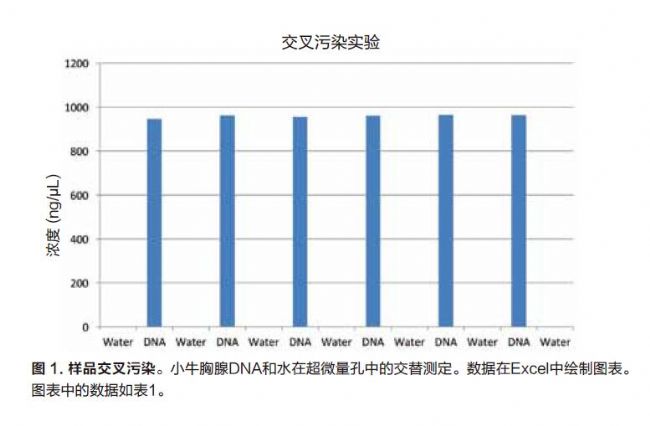
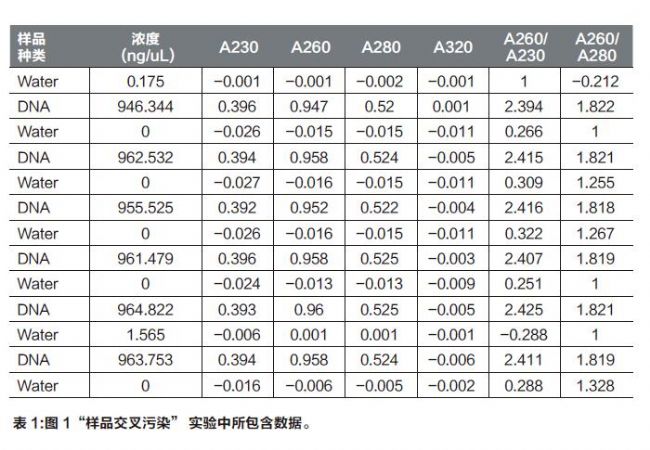
Standard curve linearity:
In Figure 2, QuickDrop shows a linear relationship between DNA concentration and dilution factor. From this experiment, we can conclude that QuickDrop has a minimum detection concentration of 1 ng/μL DNA.
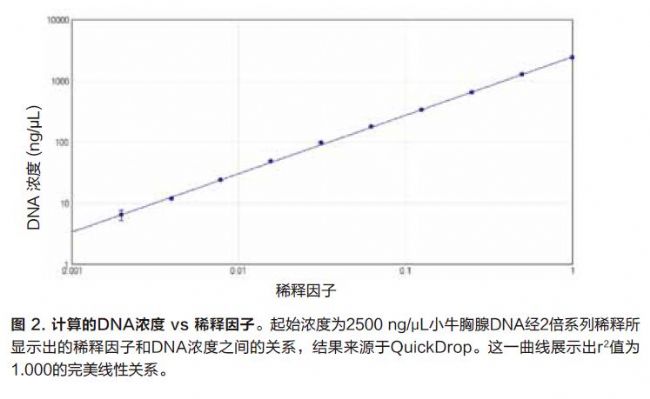
Sample volume comparison:
Three different volume DNA samples were tested in the QuickDrop ultra-micro sample wells. The calculated sample DNA concentration was consistent at different volumes (Figure 3). For best results, we recommend using a 2-μL volume because it is easier to load.
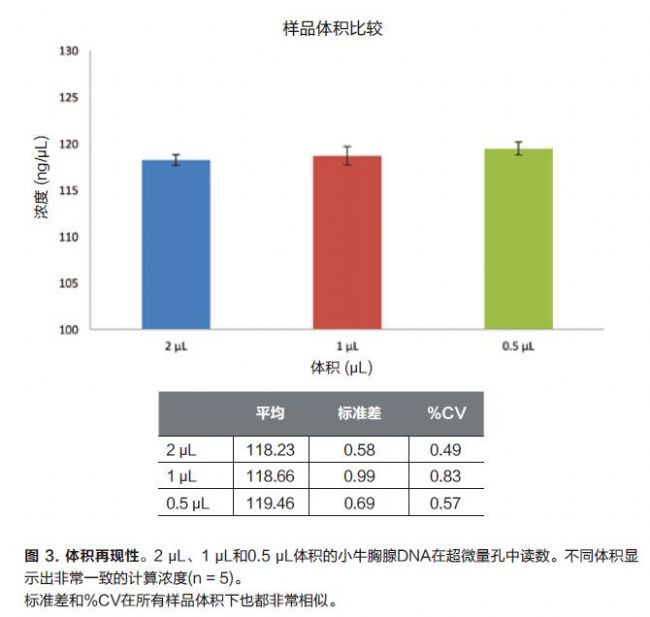
RNA verification:
The detection of RNA 250 controls demonstrates that Quick-Drop is fully capable of detecting RNA. The concentration measured is within the acceptable range provided by the Control Kit (250 ± 5 ng/μL).
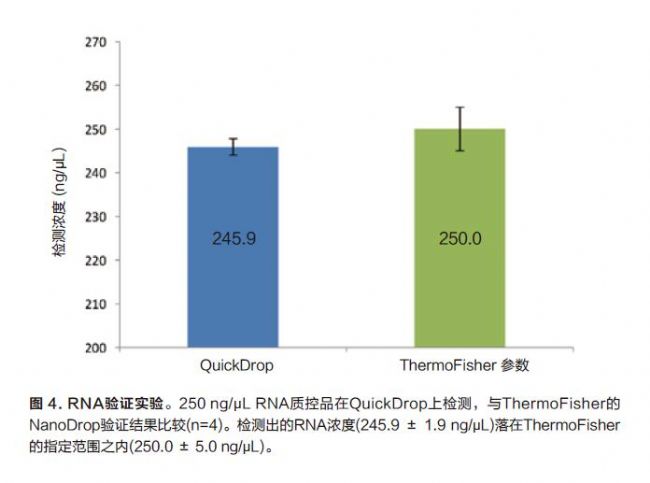
Contaminant detection:
Using the wavelength sweep function, contaminants can be identified from the sample and have an increased absorbance value at 230 nm compared to the control (Figure 5). This feature can be applied to the discovery of other types of contaminants during DNA purification, such as guanidine thiocyanate. QuickDrop's effective wavelength range is from 190nm to 1100nm, which is useful for a comprehensive analysis of all types of chemicals.
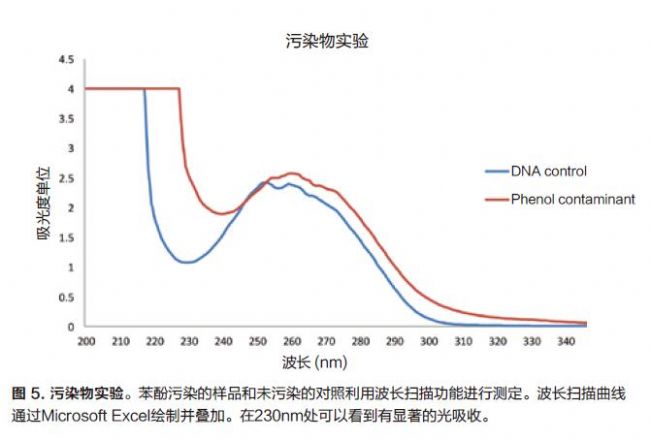
to sum up:
QuickDrop's built-in cuvette module and ultra-micro sample wells allow for very sensitive nucleic acid sample quantification and analysis. As shown above, samples as low as 0.5 μL also provide consistently high readings in ultra-micropores. At the same time, it has a very wide detection range (1 ng/μL to 2500 ng/μL) and very low sample cross-contamination.
Finally, the built-in LCD touch screen provides researchers with important information such as sample concentration and purity (Figure 6). All of these features, combined with its small and flexible size, make the QuickDrop spectrophotometer ideal for nucleic acid quantification and analysis in any laboratory setting.
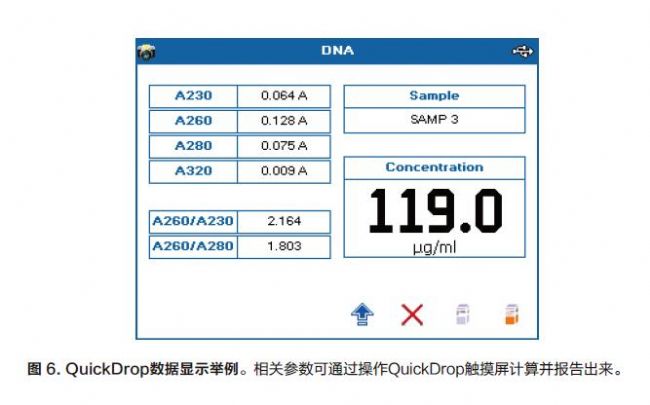
China leading manufacturers and suppliers of APIs Raw,Copper Peptide Ahk-Cu Powder, and we are specialize in Paracetamol Dc96 Injection, Besylate Powder, etc.
Now we have 3 GMP standard workshop, Meanwhile, the factory is equipped with the researching and quality inspection centre, with strong technology research and development strength. We also have 3 salesdepartments over 30 people and sell our products all over the world.
For customer`s needs, OEM service is also acceptable. If you have a good idea in new product production but lack of laboratory device and human resource, we are glad to solve this problem for you. Sincerely hope to strengthen exchanges and cooperation with friends from both home and abroad.
Api Raw,Bulk Neomycin Powder,Enrofloxacin Hcl Powder,Fipronil Oral Solution
Xi'an Henrikang Biotech Co.,Ltd , https://www.henruikangbio.com